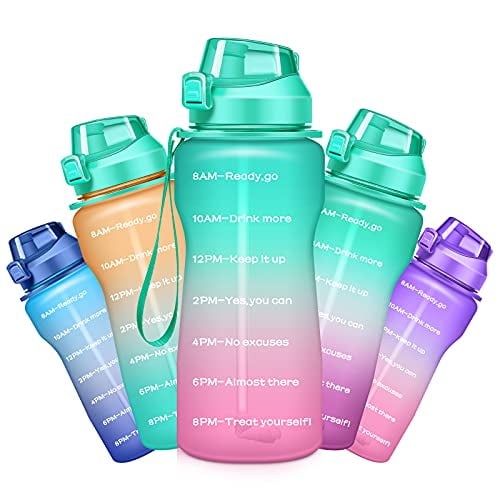100 Oz Water Bottle With Straw

The hydration landscape has irrevocably shifted. A new titan has emerged, challenging conventional water bottles and sparking both fascination and concern: the 100 oz water bottle with a straw.
Its sheer size promises all-day hydration, yet questions arise regarding practicality, health implications, and environmental impact.
The Rise of the Hydration Giant
The 100 oz water bottle, often featuring a convenient straw, has surged in popularity, fueled by social media trends and a growing awareness of the importance of adequate hydration.
Its appeal lies in its capacity – a single fill-up supposedly eliminates the need for constant refills, simplifying busy lives and promoting consistent water intake.
This convenience, however, comes with its own set of considerations.
Decoding the Nut Graf: More Than Just Water
Beyond the hype, the 100 oz water bottle presents a complex issue. It highlights the societal emphasis on hydration, questions our relationship with convenience, and raises concerns about potential overuse, material safety, and environmental consequences.
We must examine the trade-offs between perceived benefits and potential drawbacks.
This investigation aims to provide a balanced perspective, drawing on expert opinions and available data to understand the multifaceted impact of this oversized hydration vessel.
Health: A Delicate Balance
While adequate hydration is undeniably vital for health, excessive water consumption, known as hyponatremia, can be dangerous.
According to the Mayo Clinic, hyponatremia occurs when sodium levels in the blood become abnormally low, potentially leading to serious health complications.
Dr. Emily Carter, a nephrologist at University Hospital, cautions, "While rare, the availability of such a large volume could inadvertently encourage excessive water intake in susceptible individuals, particularly those with underlying kidney conditions or those engaging in intense physical activity."
The Question of "Too Much"
Determining the optimal daily water intake is highly individual and depends on factors such as activity level, climate, and overall health.
The often-cited "eight glasses a day" rule is a general guideline, not a strict prescription.
Using a 100 oz bottle as a daily target might not be suitable for everyone, potentially leading to unnecessary strain on the kidneys and electrolyte imbalances.
Materials and Safety: What's Inside Matters
The composition of the bottle itself is a critical factor. Many 100 oz bottles are made from plastic, raising concerns about BPA (Bisphenol A) and other potentially harmful chemicals leaching into the water, especially with prolonged use and exposure to sunlight.
The FDA (Food and Drug Administration) has set limits on BPA exposure, but some consumers prefer BPA-free alternatives, such as stainless steel or Tritan.
However, even BPA-free plastics may contain other chemicals of concern, prompting ongoing research into the safety of different plastic formulations.
Stainless Steel: A (Potentially) Safer Alternative
Stainless steel bottles are generally considered a safer option, as they are less likely to leach chemicals into the water.
However, the quality of stainless steel varies, and it's essential to choose bottles made from food-grade stainless steel (typically 18/8 or 304) to minimize the risk of corrosion or contamination.
Proper cleaning and maintenance are also crucial to prevent bacterial growth, regardless of the bottle material.
Environmental Impact: A Growing Concern
The proliferation of large plastic water bottles contributes to the global plastic waste crisis.
While reusable bottles are intended to reduce reliance on single-use plastics, the sheer size of the 100 oz bottle raises questions about its lifespan and eventual disposal.
The EPA (Environmental Protection Agency) reports that plastic waste continues to be a significant environmental challenge, with only a small percentage being recycled effectively.
The "Reusability" Paradox
While a durable, reusable bottle is preferable to single-use alternatives, the energy and resources required to manufacture a 100 oz bottle, particularly those made of stainless steel, are considerable.
A life cycle assessment is necessary to fully understand the environmental footprint of these bottles, considering factors such as raw material extraction, manufacturing processes, transportation, and end-of-life disposal.
Furthermore, the convenience of a large bottle might discourage users from utilizing public water fountains or tap water, further increasing reliance on manufactured products.
Practicality and Social Considerations
The size and weight of a 100 oz water bottle can be impractical for many individuals.
Carrying such a large bottle throughout the day can be cumbersome, particularly for those with physical limitations or those who commute on public transportation.
Furthermore, the visual impact of carrying an oversized water bottle might be perceived as excessive or ostentatious in certain social settings.
Marketing and Social Influence
The popularity of 100 oz water bottles is partly driven by social media trends and marketing campaigns that emphasize the importance of hydration and promote a specific lifestyle.
Influencers often showcase these bottles as essential accessories, further fueling consumer demand.
It is crucial to critically evaluate these messages and consider individual needs rather than blindly following trends.
Looking Ahead: Responsible Hydration
The 100 oz water bottle represents a complex intersection of convenience, health, and environmental responsibility.
Moving forward, consumers should prioritize informed choices, considering their individual hydration needs, the safety of the bottle material, and the environmental impact of their purchasing decisions.
Manufacturers should focus on developing sustainable materials and promoting responsible consumption patterns.
The Path to a Sustainable Future
Ultimately, responsible hydration is about finding a balance between meeting individual needs and minimizing our environmental footprint.
Choosing the right size bottle, prioritizing safe materials, and embracing reusable practices are all steps toward a more sustainable future.
The 100 oz water bottle serves as a reminder that even seemingly simple choices can have significant consequences.


















